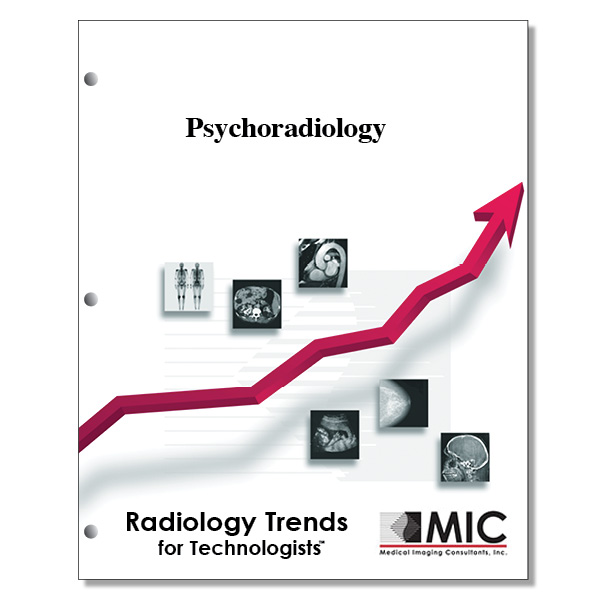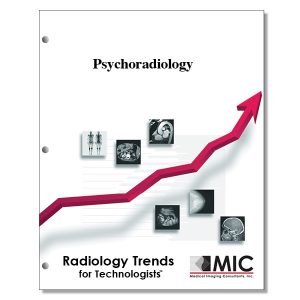

Psychoradiology
A presentation of the state of the art in the emerging field of psychoradiology.
Course ID: Q00523 Category: Radiology Trends for Technologists Modalities: CT, MRI, PET3.5 |
Satisfaction Guarantee |
$37.00
- Targeted CE
- Outline
- Objectives
Targeted CE per ARRT’s Discipline, Category, and Subcategory classification for enrollments starting after January 30, 2024:
[Note: Discipline-specific Targeted CE credits may be less than the total Category A credits approved for this course.]
Computed Tomography: 1.50
Procedures: 1.50
Head, Spine, and Musculoskeletal: 1.50
Magnetic Resonance Imaging: 3.00
Procedures: 3.00
Neurological: 3.00
Nuclear Medicine Technology: 1.50
Procedures: 1.50
Other Imaging Procedures: 1.50
Registered Radiologist Assistant: 3.50
Procedures: 3.50
Neurological, Vascular, and Lymphatic Sections: 3.50
Outline
- Introduction
- Methodologic Considerations
- Revealing the Neural Substrate of Psychiatric Disorders
- Major Depressive Disorder
- Schizophrenia
- Bipolar Disorder
- Attention Deficit Hyperactivity Disorder
- Posttraumatic Stress Disorder
- Critical Challenges and Future Directions
Objectives
Upon completion of this course, students will:
- describe the traditional classification system for psychiatric disorders
- describe the role of radiology in diagnosing psychiatric disorders
- list the factors that accelerated using brain imaging to elucidate the profile of brain abnormalities associated with different psychiatric disorders
- identify the source of the definition of psychiatric illness
- describe the factor to which cerebral deficits primarily relate
- describe the imaging technique used to detect changes in cortical thickness
- describe the imaging technique used to evaluate white matter deficits
- identify the imaging technique that was almost exclusively used in early psychiatric imaging studies
- identify the imaging technique used to obtain information about brain metabolism
- list the neurotransmitters evaluated by MR spectroscopy in psychiatric disorders
- compare the clinical usefulness of multiple imaging modalities
- identify the imaging modality that has proved to be the most widely used and informative strategy for psychiatric imaging
- describe the psychiatric disorder for which CT has been used to depict ventricular enlargement
- identify the imaging modality that is more sensitive to perfusion changes in the brain
- identify the imaging modality that is used for noninvasive measurement of changes in hemoglobin concentration
- describe the technique that is used to quantify topologic properties of brain networks
- identify the variable that appears to moderate the degree of hippocampal volume loss in MDD patients
- describe the regions of the brain in which cortical thickness changes should be analyzed in MDD patients
- list the regions of the brain that demonstrate substantially lower white matter FA values in patients with MDD
- define the only major cause of mortality in psychiatry
- list the brain circuitries that demonstrate abnormalities in patients with depression
- describe the tool that was used to distinguish MDD from bipolar disorder and schizophrenia in a multisite study
- identify the region of the brain that yielded the greatest diagnostic classification accuracy for distinguishing first-episode adults with MDD from controls
- identify the region of the brain used for treatment response prediction in depression
- describe the percentage of the population affected by schizophrenia
- list the negative symptoms demonstrated by schizophrenia patients with greater temporal gray matter volume loss
- list the factors that likely contributed to the non-overlapping and scattered white matter tract findings seen in 23 published articles on schizophrenia
- identify the brain regions that demonstrate volume reduction schizophrenia patients
- describe the previous name for bipolar disorder
- identify the component of the limbic system that may be involved in the pathophysiology of affective disorders
- identify the region of the corpus callosum in which patients with bipolar disorder demonstrate white matter deficits
- describe the imaging modality that has proven to have high value in understanding and evaluating brain alterations in pediatric patients with psychiatric disorders
- describe a potential target for development of novel bipolar disorder treatments
- define the psychiatric disorder that has an onset during childhood
- describe a central neurobehavioral impairment feature of ADHD
- list the proposed targets for therapeutic interventions in patients with ADHD
- identify the most studied brain structure in patients with PTSD
- describe the patient groups that have demonstrated smaller hippocampal volumes in PTSD studies
- identify the specific brain networks affected by PTSD
- describe a reported familial risk factor for PTSD after psychologic trauma
- list the psychiatric disorders that share anatomic and functional deficits in the default mode, salience, emotional regulation, and central executive networks
- list the brain networks considered to be the most vulnerable in all of the psychiatric disorders
- describe the criticism of current symptom-based subtyping strategies for schizophrenia, depression, and autism
- list the programs that contain very large imaging data sets that required new analysis methods to integrate multimodal information
- list the nonpharmacologic treatments that have been used to modulate the function of emotional circuitry
